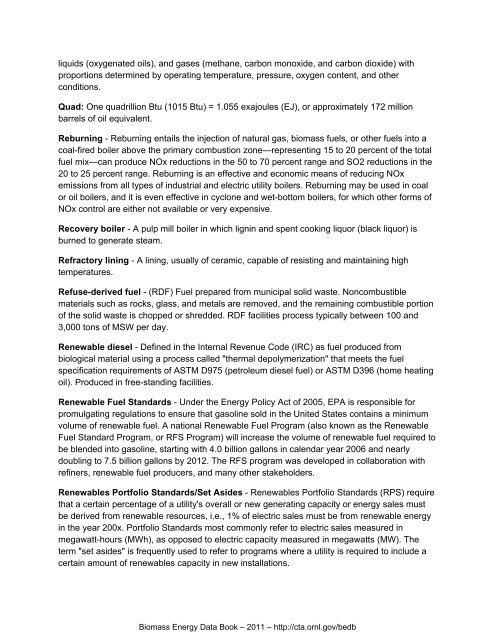Biomass Energy Data Book: Edition 4 - Full Document - Center for ...
Biomass Energy Data Book: Edition 4 - Full Document - Center for ...
Biomass Energy Data Book: Edition 4 - Full Document - Center for ...
You also want an ePaper? Increase the reach of your titles
YUMPU automatically turns print PDFs into web optimized ePapers that Google loves.
liquids (oxygenated oils), and gases (methane, carbon monoxide, and carbon dioxide) with<br />
proportions determined by operating temperature, pressure, oxygen content, and other<br />
conditions.<br />
Quad: One quadrillion Btu (1015 Btu) = 1.055 exajoules (EJ), or approximately 172 million<br />
barrels of oil equivalent.<br />
Reburning - Reburning entails the injection of natural gas, biomass fuels, or other fuels into a<br />
coal-fired boiler above the primary combustion zone—representing 15 to 20 percent of the total<br />
fuel mix—can produce NOx reductions in the 50 to 70 percent range and SO2 reductions in the<br />
20 to 25 percent range. Reburning is an effective and economic means of reducing NOx<br />
emissions from all types of industrial and electric utility boilers. Reburning may be used in coal<br />
or oil boilers, and it is even effective in cyclone and wet-bottom boilers, <strong>for</strong> which other <strong>for</strong>ms of<br />
NOx control are either not available or very expensive.<br />
Recovery boiler - A pulp mill boiler in which lignin and spent cooking liquor (black liquor) is<br />
burned to generate steam.<br />
Refractory lining - A lining, usually of ceramic, capable of resisting and maintaining high<br />
temperatures.<br />
Refuse-derived fuel - (RDF) Fuel prepared from municipal solid waste. Noncombustible<br />
materials such as rocks, glass, and metals are removed, and the remaining combustible portion<br />
of the solid waste is chopped or shredded. RDF facilities process typically between 100 and<br />
3,000 tons of MSW per day.<br />
Renewable diesel - Defined in the Internal Revenue Code (IRC) as fuel produced from<br />
biological material using a process called "thermal depolymerization" that meets the fuel<br />
specification requirements of ASTM D975 (petroleum diesel fuel) or ASTM D396 (home heating<br />
oil). Produced in free-standing facilities.<br />
Renewable Fuel Standards - Under the <strong>Energy</strong> Policy Act of 2005, EPA is responsible <strong>for</strong><br />
promulgating regulations to ensure that gasoline sold in the United States contains a minimum<br />
volume of renewable fuel. A national Renewable Fuel Program (also known as the Renewable<br />
Fuel Standard Program, or RFS Program) will increase the volume of renewable fuel required to<br />
be blended into gasoline, starting with 4.0 billion gallons in calendar year 2006 and nearly<br />
doubling to 7.5 billion gallons by 2012. The RFS program was developed in collaboration with<br />
refiners, renewable fuel producers, and many other stakeholders.<br />
Renewables Portfolio Standards/Set Asides - Renewables Portfolio Standards (RPS) require<br />
that a certain percentage of a utility's overall or new generating capacity or energy sales must<br />
be derived from renewable resources, i.e., 1% of electric sales must be from renewable energy<br />
in the year 200x. Portfolio Standards most commonly refer to electric sales measured in<br />
megawatt-hours (MWh), as opposed to electric capacity measured in megawatts (MW). The<br />
term "set asides" is frequently used to refer to programs where a utility is required to include a<br />
certain amount of renewables capacity in new installations.<br />
<strong>Biomass</strong> <strong>Energy</strong> <strong>Data</strong> <strong>Book</strong> – 2011 – http://cta.ornl.gov/bedb
















